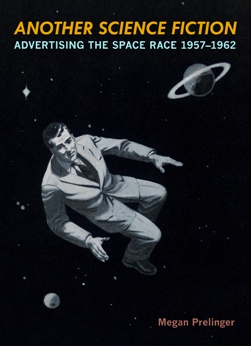When you think of using databases to plan a story—if you ever think of such a thing—do your eyes glaze over? Not if you’re Megan Prelinger. But then Prelinger tends to find her own way to respond to information challenges. Frustrated by aspects of academic research (“even though I really did love school,” she says), Prelinger dropped out of academia to become an independent scholar and spent the next five years with her partner, Rick, creating her own privately funded public library.
 The Prelinger Library ended up specializing in several niches, including land use history and the electronic and telecommunications industries. And then at one point several years ago, Prelinger had the opportunity to acquire large runs of Aviation Week and Missiles and Rockets magazines for the library. When she went through the issues, she found the ads strangely compelling. It’s easy to see why: spaceships travel on solar sails, a businessman in a suit floats in outer space, an Air Force rocket shoots out from what must be the hands of God (or very, very big engineers). The images and words tapped into her fascination with science fiction and Cold War-history.
The Prelinger Library ended up specializing in several niches, including land use history and the electronic and telecommunications industries. And then at one point several years ago, Prelinger had the opportunity to acquire large runs of Aviation Week and Missiles and Rockets magazines for the library. When she went through the issues, she found the ads strangely compelling. It’s easy to see why: spaceships travel on solar sails, a businessman in a suit floats in outer space, an Air Force rocket shoots out from what must be the hands of God (or very, very big engineers). The images and words tapped into her fascination with science fiction and Cold War-history.
“I had a sense that there would be historical narratives within those trade magazines,” Prelinger said in a recent phone conversation. “And that that might shine some light on that era and yield some stories that hadn’t been told before. But when I first started investigating, I didn’t know what I would find at all.”
Her five-year fascination became Another Science Fiction: Advertising the Space Race 1957-1962, a look at how the U.S. drive to the moon recruited people on the ground. To explore what ideas were lurking in the ads, Prelinger came up with a way to pool them:
 While Prelinger lays out a new part of the history of the space race and the technology that made it possible, she also address themes in advertising and how those themes shifted over time. Rather than just using images to illustrate her argument, Prelinger's systematic look at the magazine ads results in a story in which the pictures really create the narrative.
While Prelinger lays out a new part of the history of the space race and the technology that made it possible, she also address themes in advertising and how those themes shifted over time. Rather than just using images to illustrate her argument, Prelinger's systematic look at the magazine ads results in a story in which the pictures really create the narrative.
It's not your typical approach, and it would be overkill for most news projects. But for journalists working with historical images, compiling large sets of pictures for retrospectives, or telling stories via pools of submissions (as The New York Times did recently with A Moment in Time), there would likely be interesting narratives buried in the numbers that might yield surprising stories about the subjects, the photographers and the audience.
“I felt like the database revealed things,” says Prelinger. “I felt smarter, like I’d really learned something about the material, a more sophisticated way of looking at it than I’d started with.”
 The Prelinger Library ended up specializing in several niches, including land use history and the electronic and telecommunications industries. And then at one point several years ago, Prelinger had the opportunity to acquire large runs of Aviation Week and Missiles and Rockets magazines for the library. When she went through the issues, she found the ads strangely compelling. It’s easy to see why: spaceships travel on solar sails, a businessman in a suit floats in outer space, an Air Force rocket shoots out from what must be the hands of God (or very, very big engineers). The images and words tapped into her fascination with science fiction and Cold War-history.
The Prelinger Library ended up specializing in several niches, including land use history and the electronic and telecommunications industries. And then at one point several years ago, Prelinger had the opportunity to acquire large runs of Aviation Week and Missiles and Rockets magazines for the library. When she went through the issues, she found the ads strangely compelling. It’s easy to see why: spaceships travel on solar sails, a businessman in a suit floats in outer space, an Air Force rocket shoots out from what must be the hands of God (or very, very big engineers). The images and words tapped into her fascination with science fiction and Cold War-history.“I had a sense that there would be historical narratives within those trade magazines,” Prelinger said in a recent phone conversation. “And that that might shine some light on that era and yield some stories that hadn’t been told before. But when I first started investigating, I didn’t know what I would find at all.”
Her five-year fascination became Another Science Fiction: Advertising the Space Race 1957-1962, a look at how the U.S. drive to the moon recruited people on the ground. To explore what ideas were lurking in the ads, Prelinger came up with a way to pool them:
I started a project of low-res image capture, then I built a FileMaker database. I’m a bit of a FileMaker hobbyist. It was a way to organize my thoughts about the images and to be able to track which ones appeared when and where and how often. I ultimately spent a whole year just cataloging them, and building the database and exploring different ways to sort and tag them. That’s how the shape and structure of the book emerged…
The database ended up with about 600 records. As the research became more developed, the database came to be a chapter layout. It was really exciting—a real learning process. I’d started with preconceived assumptions, such as that there would be a chapter on Western motifs and manifest destiny and frontier mythology. That seemed like a given. But when I got into it, I found that most of the ads that I tagged with those keywords fit more meaningfully within a different part of the narrative. The Western frontier chapter idea eventually dissolved.
What do they say to filmmakers? “First throw away your favorite shot, and then edit with what you have left.” That’s the kind of learning process I went through. A lot of my assumptions about what the material was after casually flipping through began to change as I tagged the material itself. It started to take on different forms than I was able to see without the database structure.
 While Prelinger lays out a new part of the history of the space race and the technology that made it possible, she also address themes in advertising and how those themes shifted over time. Rather than just using images to illustrate her argument, Prelinger's systematic look at the magazine ads results in a story in which the pictures really create the narrative.
While Prelinger lays out a new part of the history of the space race and the technology that made it possible, she also address themes in advertising and how those themes shifted over time. Rather than just using images to illustrate her argument, Prelinger's systematic look at the magazine ads results in a story in which the pictures really create the narrative.It's not your typical approach, and it would be overkill for most news projects. But for journalists working with historical images, compiling large sets of pictures for retrospectives, or telling stories via pools of submissions (as The New York Times did recently with A Moment in Time), there would likely be interesting narratives buried in the numbers that might yield surprising stories about the subjects, the photographers and the audience.
“I felt like the database revealed things,” says Prelinger. “I felt smarter, like I’d really learned something about the material, a more sophisticated way of looking at it than I’d started with.”


